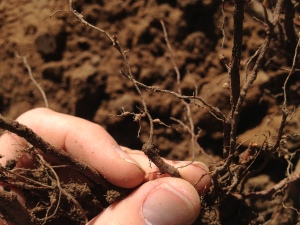
Late fall is a good time to consider nematode sampling. Sampling may be important to perform if lack of vigor or poor growth is observed within an orchard. Samples should be taken once the soil begins to cool in October. For best results, multiple soil samples should be taken, with a minimum of one sample per soil type present in the orchard. If soils are relatively uniform, two to three samples should be made for fields smaller than 60 acres. Five or six samples are needed for for larger uniform fields. A composite of 5-7 different spots within the soil type or field quadrant should be pooled (mixed and combined) as one “sample.” Soil samples should be taken at a depth of 15″-20″ within the rootzone of the tree. Once enough samples have been collected, they should be placed in a properly labeled bag, kept cool and out of the sun, and submitted to a lab to conduct the nematode analysis.
There are three different soil-borne nematode species within California that are parasitic to almonds. The common names for these three species are Rootknot (Meloidogyne sp.), Ring (Mesocriconema xenoplax), and Lesion (Pratylenchus penetrans). Historically, Rootknot nematode was a significant problem until resistant rootstocks were developed. As the name suggests, rootknot nematode causes galls or knots to form on the roots (photo above), leading to reduced productivity and low vigor. Many –but not all- modern rootstocks are resistant to rootknot nematode Rootstocks ‘Lovell,’ ‘Krymsk-86,’ and ‘Paramount,’ or ‘GF677’ are known to be susceptible to this devastating pest. Ring nematodes, which are more common in sandy soils, can cause severe stunting in almond trees as well as predispose the tree to bacterial canker. There is no true resistance to ring nematodes in current rootstocks, but ‘Viking’ and ‘Lovell’ appear to be the most tolerant. Lesion nematodes are found in all soil types. It causes stunting of trees that impacts vigor and yield. Typically, trees with high inherent vigor are able to “outgrow” the stunting caused by this nematode. Therefore, more vigorous rootstocks (e.g. peach x almond hybrids) tend to me more tolerant of lesion nematode.
If establishing an orchard and sampling reveals high counts of nematodes, soil disturbance, cover-cropping, or soil fumigation with Telone-II containing fumigants should be considered. Although exact thresholds for nematodes have not been determined, I recommend pre-plant fumigation if the average of counts from the field samples for Ring, Lesion, and Rootknot are over 25, 50, and 50 nematodes per 500 g of soil, respectively. These approximate thresholds are lower if planting to susceptible rootstocks (e.g. ‘Lovell’ in rootknot infested soils). Cover cropping with non-host plants can help reduce nematode populations as well as improve soil structure. Examples of non-host cover crops include: true Sudangrass (not hybrid Sudangrass), barley, Merced Rye, Blando Brome, and Salina Strawberry Clover. Soil disturbance through back-hoeing of tree sites appears to reduce populations in some trials. Broadcast fumigation with Telone-II containing fumigants should be considered if populations are especially high. Planting with resistant rootstocks is also recommended for the fields with high soil nematode counts.
Within established orchards, the options for managing nematode and PRD are more limited. Dr. Michael McKenry, UC Nematologist emeritus, has found that Spirotetramat (Movento®) can reduce populations of nematodes in almonds and walnuts. Observations from within the field have been favorable. Bayer CropScience, the manufacturer, suggests applying this product as a foliar spray in the spring and fall on blocks severely impacted by nematodes. Because the product is applied to the leaves but operates against pests in the roots, it is critical to mix Movento® with a penetrating adjuvant so that it is absorbed by the leaves, where it will be translocated via the phloem down to the roots. Similarly, spring and fall sprays should be applied when there is adequate canopy cover. Other products are also available or in development, and field tests are underway. Hopefully, we will have more products in the near future.


Mehmet Coka
October 27, 2014If you apply Hydrogen Peroxid on to soil and if you apply calypso(bayer) to leafs, are also cleans nematodes.
David Doll
October 30, 2014Dear Mehmet,
Thank you for sharing. I am glad to hear that you have had success in managing nematodes with these pests. Unfortunately, these products are not registered for use within California. If possible, I will try and get them into some type of trial to determine their efficacy.
Thanks,
David